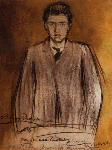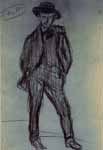|
|
|
<INSERT TITLE PAGE HERE>


Pablo Picasso was probably the most famous artist of the twentieth century. During his artistic career, which lasted more than 75 years, he created thousands of works, not only paintings but also sculptures, prints, and ceramics, using all kinds of materials. He almost single-handedly created modern art. He changed art more profoundly than any other artist of this century. Picasso was first famous for his pioneering role in Cubism, he continued to develop his art with the cultural changes of the 20th century and it might be said that Picasso lived several artistic lifetimes.
Picasso was born on October 25, 1881, in Malaga, Spain, son of an artist, Jose Ruiz, and Maria Picasso. At the age of 14, Picasso completed the one-month qualifying examination of the Academy of Fine Arts in Barcelona in just one day. From there he went to the Academy of San Fernando in Madrid, and returned to Barcelona in 1900. The years of 1901 to 1904 were known as the "blue period" because of the blue tonality of Picasso's paintings were a time of frequent changes of residence between Barcelona and Paris. During this period, he would spend his days in Paris studying the pieces of art at the Louvre and his nights enjoying the company of fellow artists at cabarets such as the Lapin Agile.
1905 and 1906 marked a change in Picasso's art. He became fascinated with the acrobats, clowns and families of the circus world. He started to paint in pinks and grays, often highlighted with brighter tones. This was known as his "rose period." In 1907, Picasso painted "Les Demoiselles d'Avignon," considered one of the great pictures of the twentieth century. He also met Georges Braque, the other leading figure of the Cubist movement, and from 1911 to 1913 the 2 men were in frequent contact.
For Picasso the 1920's were years of rich artistic exploration and great productivity. Picasso continued to design theatre sets and painted in Cubist, Classical and Surreal modes. From 1929 to 1931, he pioneered wrought iron sculpture with his old friend Julio Gonzalez. In the early 1930's, Picasso did a large quantity of graphic illustrations. In late April of 1937, the world learned of the shocking news of the saturation bombing of the civilian target of Guernica in Spain by the Nazi Luftwaffe. Picasso responded with his great anti-war painting named "Guernica."
During World War II, Picasso lived in Paris, where he turned to the art of ceramics. From 1947 to 1950, he pursued new methods of lithography.
The l950's saw the beginning of a number of large retrospective exhibits of his works. During this time he began to a paint a series of works conceived as free variations on old master paintings.
In the 1960's, he produced a monumental 50-foot sculpture for the Chicago Civic Center and in 1970, Picasso donated more than 800 of his works to the Berenguer de Aguilar Palace Museum in Barcelona.
At the age of 91, Pablo Picasso died on April 8, 1973 in Mougins, France.
In 1980, an exhibition of modern art was put on display in New York City's museum, including Picasso's art which drew over 1 million people.




